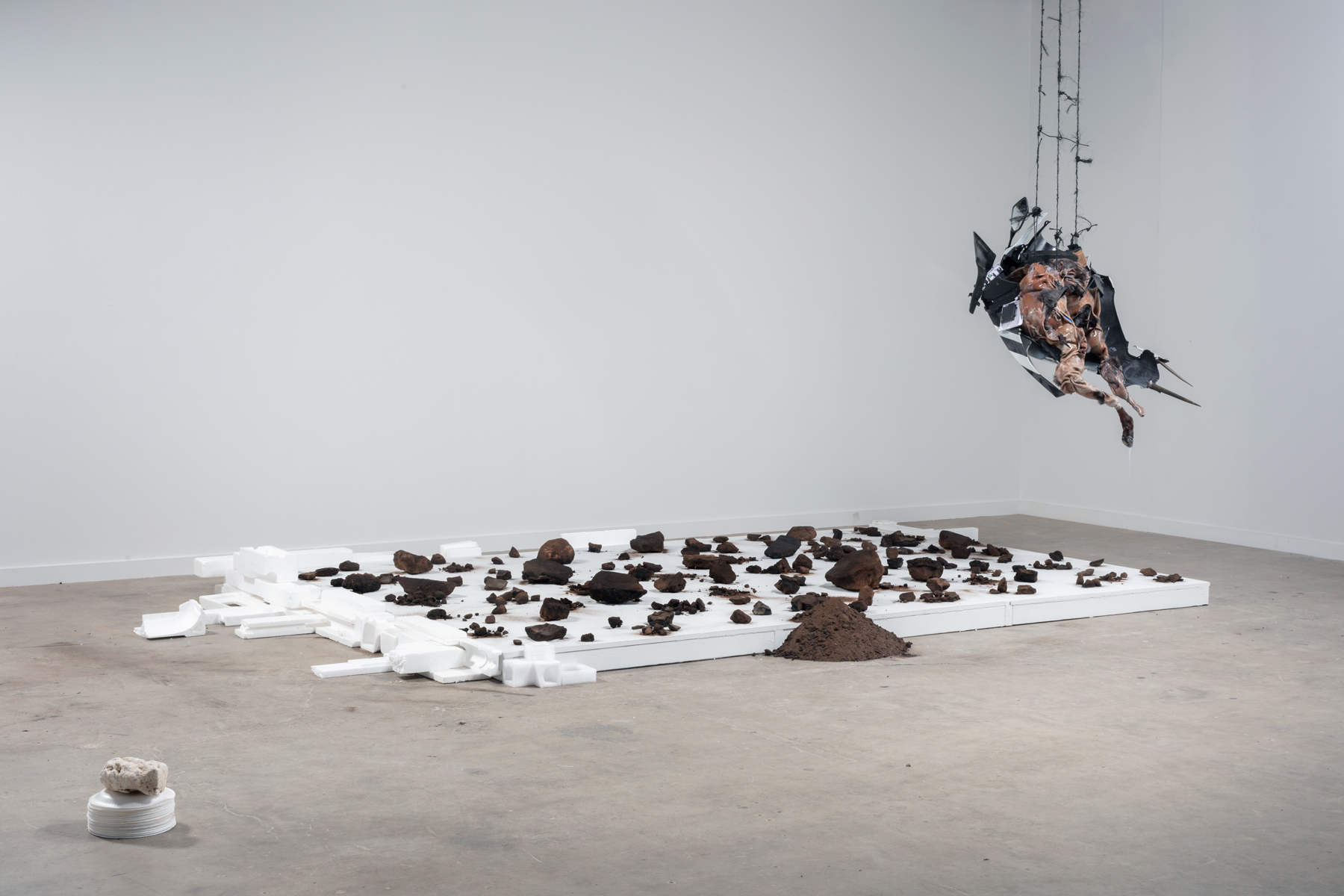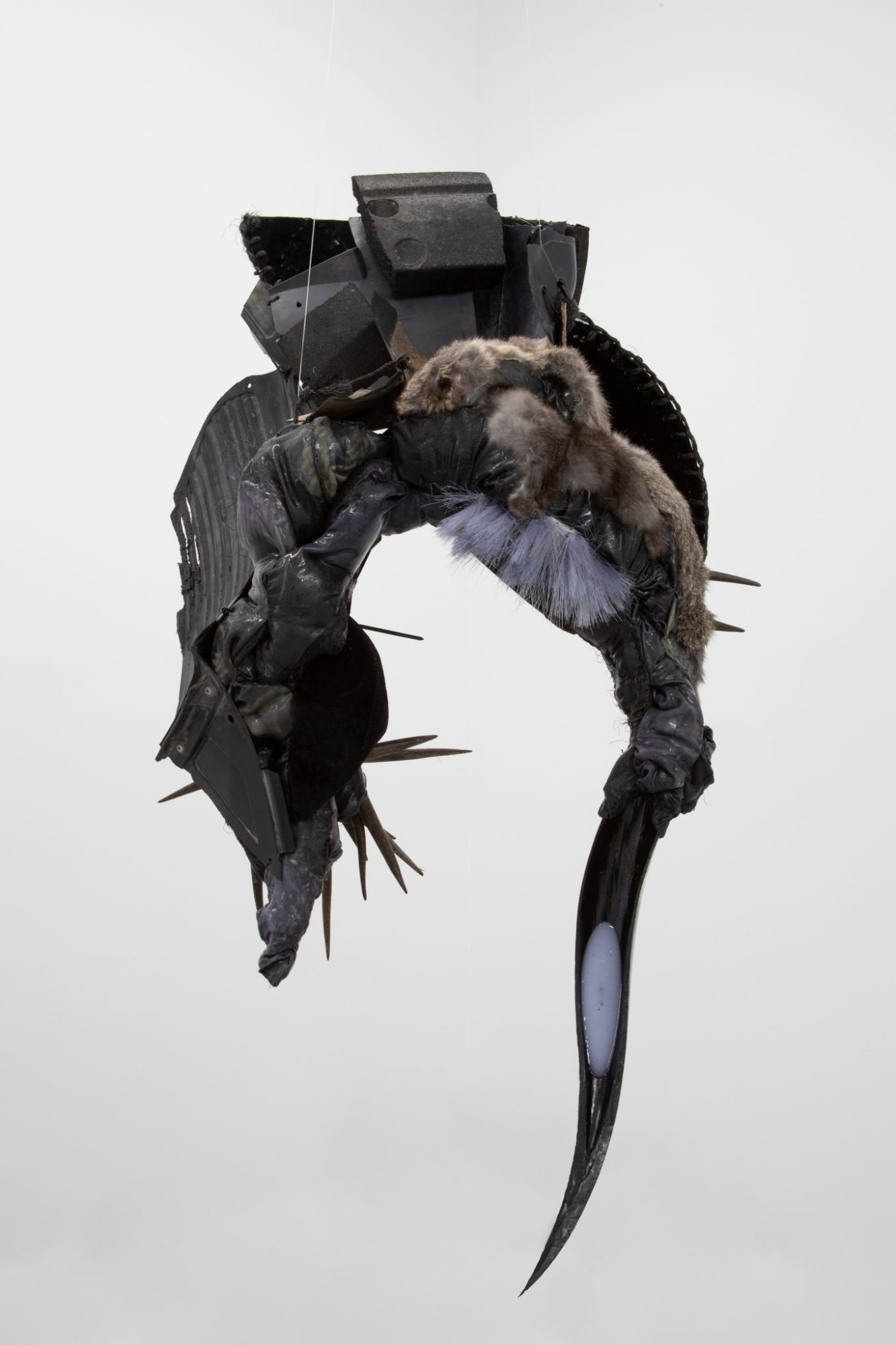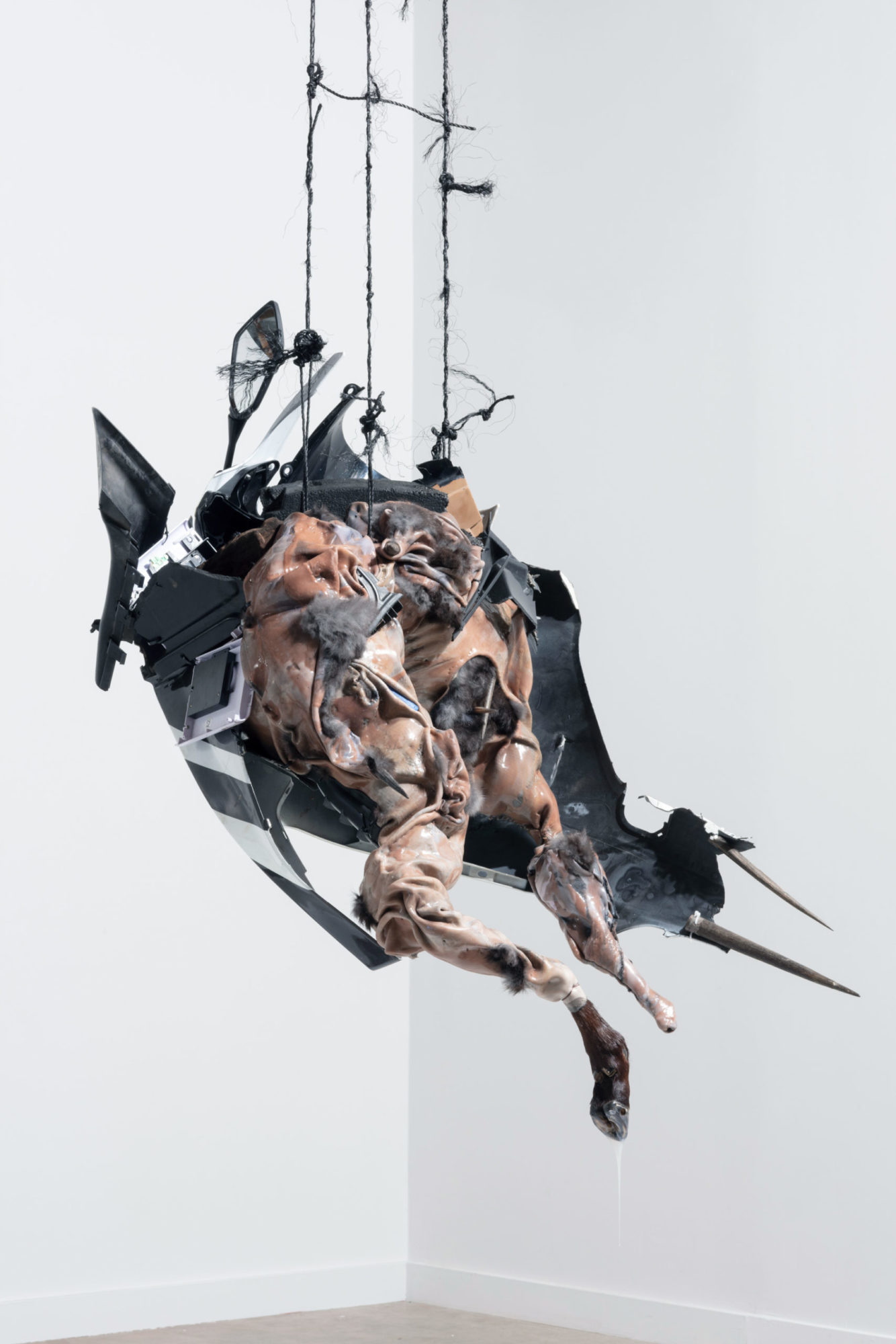Ruben Ulises Rodriguez Montoya: Devastated and Hopeful

Ruben Ulises Rodriguez Montoya, “A Being Mistakenly Called “La Nave de Kylo Ren,” installation view, 2021; material list from the artist: Cannibalized goat leg, horn tips, white and black zip ties, two black t-shirts, rabbit pelt, motorcycle part of a man with an inflated ego driving too fast on a sharp turn on Mcnutt Rd. Blue disposable shaving stick, black twine that Gabrielle braided, welding rod, white car part laying next to a palm tree while Karla and I were on route to get boba. That was the day I told her of the white gay from Tiktok that choked on boba and how much I loved the work of Teresa Margolles and Ivana Basic. Pigmented dragon skin silicone, sandrock with motor oil that I found next to a Family Dollar that leads to the border wall and then to Anapra in Juarez Mx. White shell of a boom box the day we went to Jalisco Bar and got so drunk we had to pee in between two cars because we wouldn’t make it home. Styrofoam [courtesy of the artist]
Share:
Ruben Ulises Rodriguez Montoya is an art- and myth-maker whose work distorts the imaginary lines that exist on land between states. His chimeric “lil beings,” as he calls them, are reconfigurations of found, personal, and organic materials, which he animates with allegories of displacement, inspired by ancient Mesoamerican myth and folklore. It’s not only their bestial appearance and dewy skin that makes Montoya’s creatures so attractive. Their mere existence posits the possibility of a future after and through the violence of imposed migration.
Shehab Awad: As you work, you construct mythologies around your sculptures. Have you ever thought about including that writing in the exhibition space?
Ruben Ulises Rodriguez Montoya: The story is a way in which I work around [lists of] materials. The work can exist without that [mythological] narrative, because the narrative exists within Instagram, and on my website, so I think there is a kind of visibility there. But I’m not particularly interested in a mega-didactic approach about how that storyline is encompassed in the work. The way that I think about creating an environment within the work allows me to situate it so that it doesn’t get clinicalized, or sterilized, within the coldness of a white cube. I think my story is a kind of protection against that. There’s a materials list, but then there’s also the title of the work, which also functions as a way to create an environment within the installation.
SA: You include all sorts of things within your sculptures—personal items, trash, and scrap material—yet somehow your sculptures seem alive. They don’t just look like artworks about the Anthropocene to me. They seem to be both ancient, and from a very distant future.
RURM: I like that, because I think the shape of the work feels like it’s of a deep, past time, or a body that may look like that in a thousand, or a million, years. I like the ambivalence of the work existing as though it could be a cephalopod, or the larvae of a cephalopod. A tentacular, future body that floats around space with a different kind of carapace.
SA: What usually comes first when you’re creating a body of work? Does it start with the writing?
Ruben Ulises Rodriguez Montoya, “Tochtli travels an omnibus at night down the Chihuahuan Desert to grandmothers house, to see Saint Seiya dubbed in Spanish,” 2020 [courtesy of the artist]
RURM: Since the pandemic, I’ve been trying to meditate every day. Those meditations have allowed me to see the work before it’s made. I’ve been hiking every day too. And I see my work when I hike, or when I’m watching the sunset. When I meditate, I start to envision how [these creatures] function in space and on land, specifically the kind of land that I’m accustomed to. I’ll get stuck with the problem of having a very specific materiality that I’m engaged with. Then I choose which objects or materials will respond to the work. The result is an assemblage of different perspectives and frameworks that I’m thinking about. The writing happens as I’m meditating. Or when I’m on YouTube and I see old Discovery Channel videos of how elephants or cheetahs are described—that also triggers my writing.
Ruben Ulises Rodriguez Montoya, “A carapace, and the blue blood that coagulates around it as they land and look for new environments (form III),” 2021, straw hat sombrero, lil straw hat sombrero, five Gemsbok horn tips, black sweatpants, rabbit fur pelt, found bun clip, bone-white detritus of the Rio Grande River, zip tie, horns found on a Texas rest area, pigmented dragon skin silicone [courtesy of the artist]
SA: Did you grow up near the desert?
RURM: I was born in Parral, Chihuahua, Mexico, and then—when I was two years old—we crossed over, me and my mom. I was born in the desert and then I grew up in a different kind of desert in the US, but I’ve always been a kind of a desert hoe, so…
SA: Same, honestly. When you say, “a different kind of desert”, what do you mean?
RURM: I’m talking about the boundary of the desert. I was born eight hours from the border, in a farming community. So there’s not a lot of desert, but when you [zoom] out a little, there’s a desert. I don’t have a relationship with that kind of desert, but I do have a relationship to its temperate climate and its dryness. Since I’ve been in the US, I go hiking in spaces that people don’t usually frequent. Even though there’s a vast emptiness there, I can always see [a skyline]. So, there’s never a sense that I’m the only thing in this space. But I do feel like I am alone with my thoughts, which is something that I do cherish.
SA: Do you think that exists—a moment or space where one is fully alone?
RURM: When I was younger, I used to go to the desert alone and play music. Now that I’m older, I do feel alone in the desert because I’m with my thoughts only. And after I’m finished with negotiating the problems of the day, the dreamlike aspect of who I am comes into play. I am alone in that space, and I allow the desert to take me. That’s when I start to see the materials that I’ll use to make the work.
SA: After the self-therapy session.
RURM: Right, the demons come out, and after that they’re fine.
SA: I think about the desert as where life began but also as where life can very quickly end. What does the desert symbolize to you?
RURM: A lot of deserts used to be oceans. I think I share a lot of parallels with oceanic life, even though I have no relationship to the ocean, or to beaches, or any aquatic atmosphere. Oceans are abundant with life in adapted forms. I think about the desert in the same way, only life there is in an extremely adapted form.
SA: I’ve been thinking about the meaning of the term transfiguration in relation to transition. What does transfiguration mean to you?
RURM: Transfiguration, for me, means when I’m cognizant or aware of my subjectivities and identifications, and then becoming one and hybridizing with a different kind of object, or thought, or landscape. Transfiguration is a way in which we could be hybridizing with different kinds of becomings. The term allows me to think outside of myself, to be with something else.
I think transfiguration can also describe a very corrupt process in relation to how the state, or capitalism, or migration, can create an imposed transfiguration. My work is thinking about transfiguration in comparison to assimilation—a toxicity that changes a body and compartmentalizes and constricts communities, as well.
Ruben Ulises Rodriguez Montoya, “Nosferatu in a bat state: patient zero of Spanish Influenza,” 2020, 13 x 6 x 4.5 inches [courtesy of the artist]
Ruben Ulises Rodriguez Montoya, “Oct. 23, 2019: Florida man busted feeding iguanas in jail zoo,” 2020, 16.5 x 10 x 5.75 inches [courtesy of the artist]
SA: So violence has something to do with transfiguration?
RURM: I think there’s a transfiguration in violence that our corporealities have to deal with, that can change the way we engage with our bodies. The way I assemble objects together—thinking about landscape, animals, and my own body—is a way to combat that violence, [to] ground a body that has gone through another kind of body so that it can cross over and not be stuck in that trauma and violence. My work acknowledges the violence first, then pivots to something else.
SA: Does your work imagine a utopia, in a way?
RURM: Maybe, maybe not. I’ve been applying to residencies and fellowships, and to propose something that doesn’t exist is really hard. Or to think about yourself in a future when, right now, nothing is certain .… When nothing is conducive to [feeling grounded,] it’s very difficult to imagine a utopia. We ask for a utopia, but who’s putting in the labor? Where is the scaffolding for that kind of idea? I do think that there’s a collectiveness to a utopia. We must collectively put in the work together. That’s the only way I think about achieving utopia.
SA: Utopias are in the eye of the beholder.
RURM: I think everybody has a different version of utopia, but perhaps we’re headed toward a utopia of humanity. My utopia is a very simple: a suburban life, where people have very basic needs that are met. To get there, however, we have to acknowledge the dystopia first, which I don’t think we’re doing right now. Certain animals and environments are not going to come back. There’s something very jarring about that. We have to first acknowledge the violence on our bodies, and land, and animals, before we get to utopia.
SA: But in the same way that something will vanish or be destroyed, something else will come out. With your work, I couldn’t tell whether the scenario you were presenting was optimistic or pessimistic, or whether it was just the inevitable future?
RURM: I’m a very hopeful person, but I think there is a pessimism in the way in which there’s a current imbalance to life. I do agree that some things are cut out and some others will come to replace them, but this is all a product of colonialism and a lot of really bad things—it’s really hard to swallow. I have an optimism, but it’s very far-fetched, and it’s barely there.
SA: Do you think that we are where we are because of the way that time has inevitably evolved? Or do you think that there was a specific decision or moment in time, and if that were to change, we would be somewhere completely different? … I guess I’m asking, is late-stage capitalism a [stage of] biological evolution?
RURM: I think we’ve had many chances to not go where we have—where we’re going.
SA: Right? They’ve been telling us.
RURM: There’s too much tea! We know this is not the way. I’m waiting for capitalism to become a better version of itself. A lot of companies are trying to go green, but it’s all very wishy-washy and haphazard. I’m waiting for capitalism to suffer a stinging rebuke when it can no longer function, because the environment is not allowing it to.
Ruben Ulises Rodriguez Montoya, “A Being Mistakenly Called “La Nave de Kylo Ren” (detail), 2021 [courtesy of the artist]
Our current ways of being right now have to be completely [dismantled]… But I don’t think that we’re willing to let go of carbon-based production, or our dependency on plastics. Until the oil reserves are gone. That’s when capitalism will refigure, or transfigure, itself into something we can vibe with.
SA: In March, when that cargo ship [the Ever Given], got stuck in the Suez Canal, which is such an important passage for global trading, it was like a big screwdriver had been jammed into the cogs of capitalism. Everything just stopped. I have to say, I felt really hopeful when I heard the news. Do you think being able to feel hope out of devastating realities is an ability that only traumatized subjects possess?
RURM: I think there’s always hope. I think younger generations are a lot more woke. We’re in a time where an old guard is resisting and refusing to give way and power to those who don’t look like them. I am optimistic that collective hope can emerge from these devastating moments, but I am wary of how much malaise we suffer as a society.
Ruben Ulises Rodriguez Montoya, “A carapace, and the blue blood that coagulates around it as they land and look for new environments (form I),” 2021, Straw hat sombreros, two Gemsbok horn tips, black sweatpants, rabbit fur pelt, black zip ties, black plastic fragments, pigmented dragon skin silicone [courtesy of the artist]
SA: Your work deals with current and past sociopolitical violence inflicted on Mexican asylum-seekers, especially those trying to get through the border into the US. Does bringing fantastical elements and myth-making into your work function as a strategy to have these sour conversations that nobody really wants to have?
RURM: I myself have gone through that violence, and I don’t want to be about the trauma all the time. People of color always get tokenized to speak about their traumas with a didactic approach; to share their knowledge and experiences, as if everyone doesn’t already know. As if everyone isn’t already aware. So, even though these experiences are also mine, I want to create outside of that space. One can never take away [one’s] lived experience, but I think it’s important to imagine what our work can look like outside of that trauma, beyond that political space.
SA: And in a way, that tokenization and expectation of marginalized groups of people to represent their trauma can lead to a flattening and desensitization about these topics. It gets easier to continue scrolling past these issues because they’re already widely disseminated.
RURM: People love trauma porn, but—enough. There was a point where I felt that my work had to embrace and be geared toward a certain community. I’m trying to push against that in tandem with something else that allows me that space of the imaginary and a fantastical becoming. A sculpture that can be mimetic of various ideas, not just my own experience.
SA: Did you ever feel pressured into becoming an ambassador of the trauma that you carry, working in the US?
RURM: I was cognizant of that in grad school during conversations with other graduate students. Once I was able to brush that aside, that’s when things really started to pop off. Institutional spaces [expect] artists to be arbiters for an entire community that one may not even know, or [that one is] not in full contact with. I do think that the closer you get to White spaces, the greater the desire is to slurp up that kind of [tokenizing] content.
SA: What do you think happens to folklore, its stories and its monsters, when the communities who bring that folklore to life are displaced, forced away from the origins of their stories?
RURM: I think folklore is very queer in the sense that it’s always evolving. I think folklore is the one thing you can take with you when you’re displaced. When you are uprooted very quickly, you leave behind material. What you end up taking with you are the stories. My mom told me a lot of stories when I was growing up, and those are the things that I remember. And those are the ways in which I created my mythology of Mexico, even though I didn’t live there my whole life. There’s a collective fabric of storytelling that allows us to fill in the gaps, or braid a story into another, and create characters that acquiesce to our experiences. Even [the legendary] chupacabras: they embody the histories of whomever continues to bring them to life in their stories. There’s a gnarled queerness to [chupacabras], because they can represent any kind of fear or violence that one has experienced.
SA: Last question: what’s your favorite animal?
RURM: I love the pangolin, but I also love the anteater …. I’ll go for the anteater.
Shehab Awad is an independent curator and writer from Cairo, Egypt, currently based in New York City. He/she is founding director of Executive Care, an all-encompassing agency at the service of artists.





